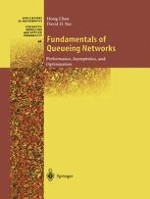2001 | OriginalPaper | Buchkapitel
Kelly Networks
verfasst von : Hong Chen, David D. Yao
Erschienen in: Fundamentals of Queueing Networks
Verlag: Springer New York
Enthalten in: Professional Book Archive
Aktivieren Sie unsere intelligente Suche, um passende Fachinhalte oder Patente zu finden.
Wählen Sie Textabschnitte aus um mit Künstlicher Intelligenz passenden Patente zu finden. powered by
Markieren Sie Textabschnitte, um KI-gestützt weitere passende Inhalte zu finden. powered by
The central approach used in this chapter, just as in Section 2.6, is to examine a stationary Markov chain together with its time-reversal: another Markov chain defined through reversing the time index of the original chain. Applying this technique to the Jackson network in Section 2.6, we not only recovered the product-form distributions derived earlier in Chapter 2 but also established the Poisson property of the exit processes from the network. In particular, we showed that in equilibrium the Jackson network preserves the Poisson property of the input processes to the network, such that the exit processes are also Poisson. This “Poisson-in-Poisson-out” property is the main motivation here for defining and studying a class of so-called quasi-reversible queues. This class is an extension of the basic M/M(n)/1 queues, which constitute the nodes in a Jackson network, to allow multiclass jobs and more general arrival and service disciplines, while still preserving the Poisson-in-Poisson-out property. It turns out that a general multiclass network, known as a Kelly network, which connects a set of quasi-reversible queues through some very general routing schemes, still enjoys the basic properties of the Jackson network, namely, the product-form equilibrium distribution and the Poisson-in-Poisson-out property.
